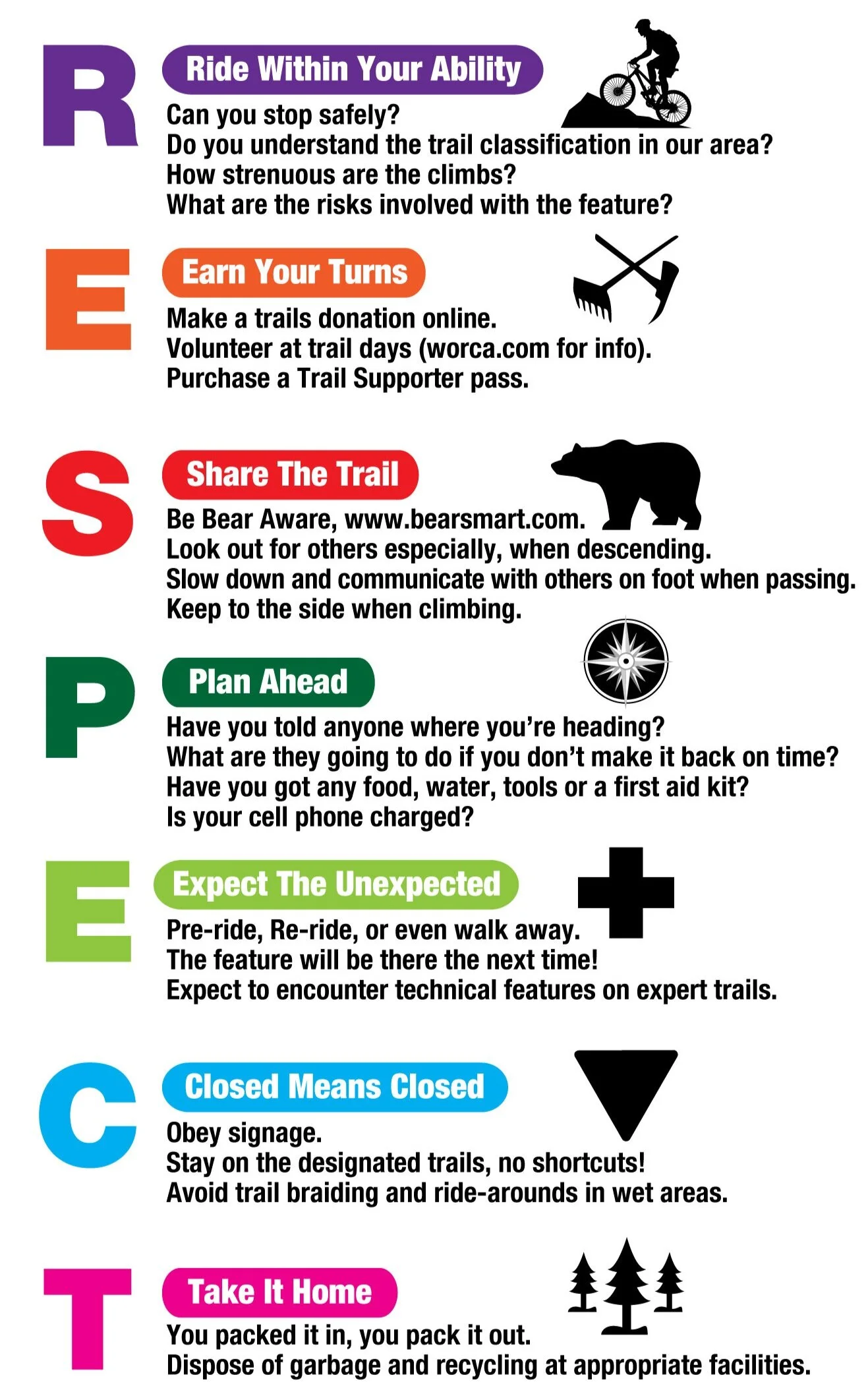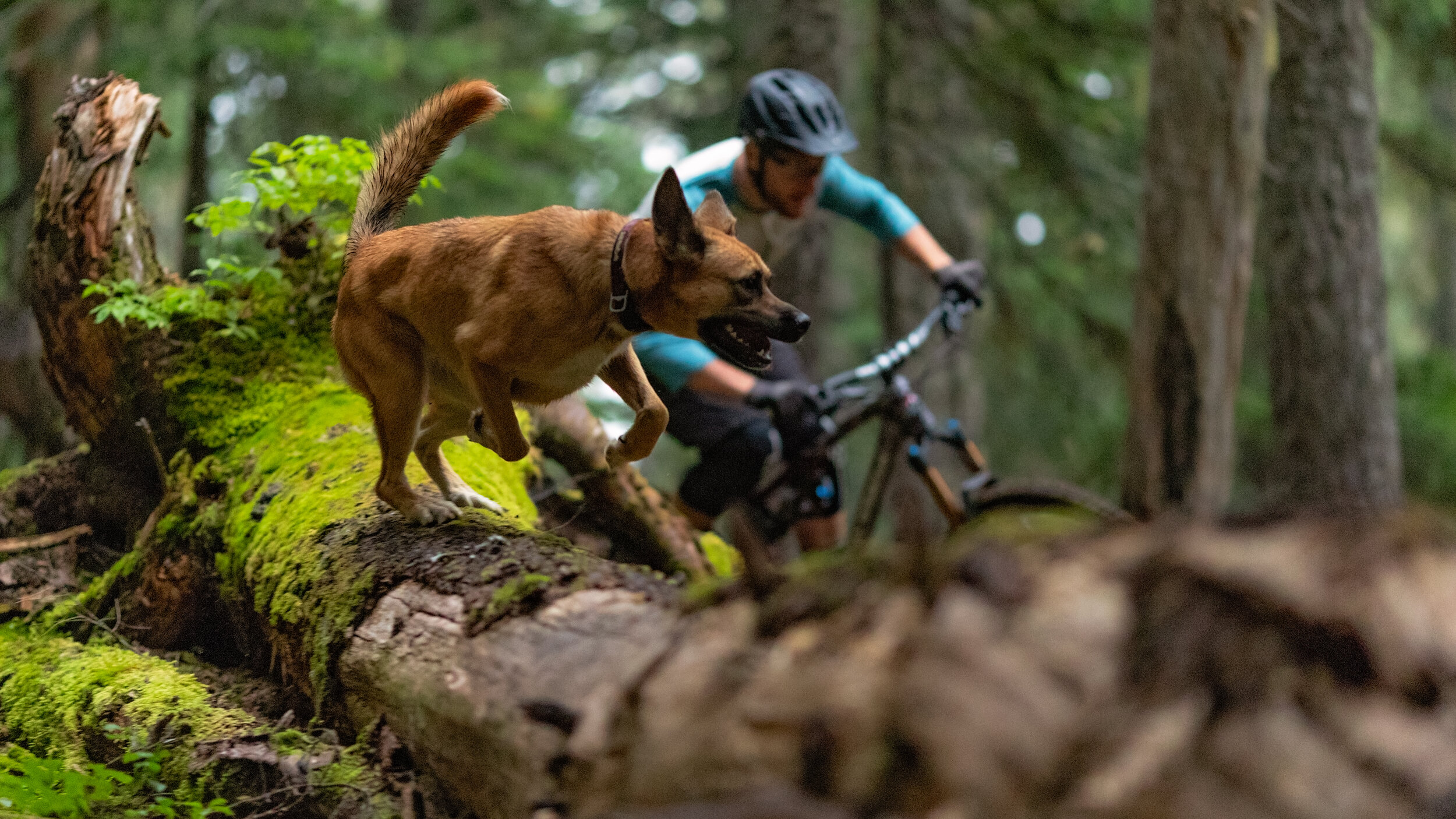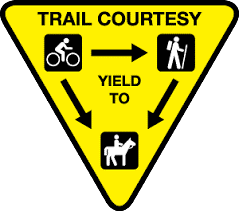Trail Etiquette.
Whistler Off Road Cycling Association (WORCA) maintains public trails in the Whistler Valley. WORCA works closely with the Resort Municipality of Whistler (RMOW), Crown Land recreation managers, and other community stakeholders to maintain these trails, manage land-use conflicts and uphold a common Trail Etiquette. It is important that trail users are familiar with trail etiquette in order to enjoy these amenities safely.
WORCA is committed to responsible stewardship of the Whistler trail network and has created RESPECT signage and guidelines below to communicate best practices to trail users. Stay alert and stay safe!
Who yields to whom?
These days we don’t see many horses in the Whistler Valley, but the general trail user should adhere to this sign as a rule of thumb.
Whistler is a major mountain bike destination. You will encounter mountain bikers on most trails as well as many hikers, you may also encounter Trials motorcycles on some trails. To give you some background, Trials bike users built some of Whistler’s classic trails which have now been adopted into our mountain bike trail network and WORCA. Note that not all trails are designated for non-motorized use only, please use common sense and respect when encountering other user groups.
A guide for all trail users
In order to keep the trails fun and open for everyone to enjoy, show respect for your fellow trail goers, keep the wilderness wild, be kind, considerate, and courteous to all living things. In this way we can all get along. Here are a few more tips to keep the good times rolling.
Stay on the trail.
Do not cut switchbacks or take shortcuts unless there is one specified.
Stay to the right side on wider paths.
Use common sense and give space when encountering others.
Pass on the left.
Communicate with the humans you encounter. Let them know you’re approaching and would like to get past. Who knows, you might even meet a new friend.
If you stop, move off the trail.
If you find yourself wrapped up in the beauty of a grand vista, taking a rest, crushing a bar or doing some trailside bike mods, please clear the trail so others can past. Be aware of the forest and try to minimize your off trail impact.
Greet people you meet.
We’re all outside for the same or similar reasons. Say hi to your fellow trail goers. Ask them how their day is. Share information and enhance each other’s experience.
groups yield to single or pairs of hikers/bikers.
It’s harder for a group to get off the trail so often times singles will stop and let you all pass, but it’s their call. Communication is the key to success.
Travel in single file when in a group
Make sure everyone in your group understands what actions to take when encountering hikers, bikers, horses and other wildlife such as bears.
When meeting a horse:
Get off the trail on the downhill side. Horses will tend to bolt uphill when spooked. Also, you waiting on the uphill side looks more like a predator waiting to pounce.
Quietly greet the rider and ask if you are ok where you are.
Stand quietly while the horses pass.
When you encounter a bear:
Read this document about bears and biking.
Don’t leave any markers when hiking off-trail.
Cairns, ducks, or little piles of rocks are not needed. Markers tend to concentrate traffic which creates un-managed trail scars.
Read trail-head guidelines.
There may be specific rules for the trail you are on, for example, a mountain bike descent trail.
Guidelines for bikers
Cyclist travelling uphill have the right of way.
Public trails are not a race course.
If you want to get the lead out, do it on a race day/night.
You must stop if you approach someone that is crossing a narrow bridge or negotiating a narrow piece of trail with limited space, coming up or going down.
Let faster riders pass you as soon as you can.
Sometimes uphill bikers will prefer to stop and let you pass coming down so they can get a short break – the uphill biker should be allowed to make that decision.
When using downhill tracks be courteous and communicate with those you meet and pass.
Keep your eyes and ears open.
Use all your senses and your common sense. Safety first.
Protect the environment
Pack It In – Pack It Out.
Leave only tread marks. Keep the wilderness wild. We all have to do our part to keep these lands as healthy as possible.
Take a photo as a memento of your adventure.
Leave nature the way nature intended nature to be. Take only photos. And make sure you’re not in the middle of the trail or obstructing other trail users.
Report vandalism.
If there is contact information at the trail-head, tell the managing agency about any destruction or management concerns or requirements that you notice.
Mountain bikers can help prevent the spread of invasive plants by cleaning shoes, bikes and pets before leaving the trail-head or moving to a new trail-head. Learn more about how to Play Clean Go.
Seasonal conditions and weather
Be considerate of the environment and local trail management plans. If you ride in the wet, ride trails that are appropriate. Consider the impact of riding in wet and rainy conditions.
In early season during snowmelt or in October once the fall rain comes certain areas may be deemed closed due to impact and erosion. If you ride the trails before they are dry, you will damage the trail dramatically. Be patient.
In Alpine terrain, if a trail is open with a few snow patches, stay on the snow on the trail. Braiding a new trail causes extensive damage to an area. The newly developed Sproatt network, for example, will only be opened once the snow is gone in the Alpine (once we can see the trail and stick to it). Other areas in the valley may be closed by builders because of snowmelt.
Consider the time of year and choose appropriate trails for riding in wet conditions. Ride accordingly and follow trail etiquette, check if trails are open or closed before setting off for a ride.
Trailforks is a good guide to what trails are open and closed. You can also report downed trees, trail damage, and other issues on Trailforks.
Human factors
Whistler, along with the whole Sea to Sky Corridor, has become a mecca for riding bikes. Much effort and money is being spent to manage the trails and environment around it. Consider the heavy traffic you are part of which adds to the impact and cost of maintenance and development. Support the local trail association of the place you are visiting it really does make a difference:
We all love new trails. Please don’t ride them prematurely.
WORCA is proud to be able to work with local government and stakeholders to develop the trail network and offer new trails for people to ride. But it is disrespectful to the builders and planners who are putting time and effort into creating new trails when unfinished trails are ridden prematurely. Be aware of the privileges you enjoy as a trail user with respect to access and recognize the impact you can have on it and on nature. Respect what we have and who provides it.
Join your local club/association on Trail Maintenance days and meet the people who work hard to develop and maintain the trail network. If you want your voice heard and your opinion to count, the community volunteer days are a great place to speak with trail builders and stewards to learn about the trail network and its evolution.
Please, lead by example and follow trail etiquette, together we can make our trail network a pleasure for everyone to enjoy now and in the future.
Electric-bikes
E-bikes allow more people to travel farther and quicker into places they could not so easily access before. This opens up a number of concerns around user conflict, trail safety, and damage to trails that WORCA monitors. E-bike riders are directed to be extra considerate on public trails and be aware that faster speeds in all directions is a concern for collisions on multi-use trails. For more info, check out our E-bikes Page.







